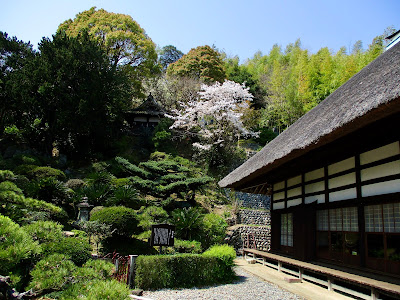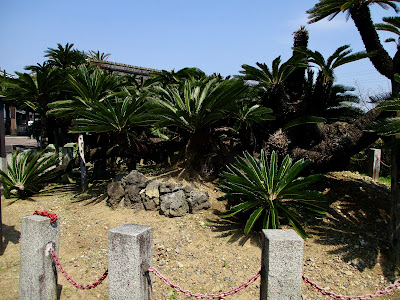Kanpuzan Ryuge-ji
I noticed this sign at the bus stops as I passed them starting mid-week. I could read Coronavirus, so I took a photo of the sign to study it and see what it said. I think it says because of the Coronavirus, the Saturday schedule will be the Sunday/Holiday schedule starting April 4th. In my neighborhood that means there will be one bus an hour on Saturdays instead of the normal two an hour. That doesn't affect me or my Saturday travels.
Yesterday, I walked to a temple near my work place and near where I used to live. I visited several years ago, but needed to get out for a walk anyway so this was a good place to visit a second time. The Main Gate is flanked by the Evil-Averting Gate and the Fortune Gate.
The entry fee is 300 yen, same as when I first visited. The signage is all in Japanese, but they did give me the English version of the printed information.
This red door is the Gyokei-mon (the Imperial Visit Gate).
This is the Founders Hall, which is decorated with 220 ceiling panel paintings and enshrines St. Nichiren.
The Main Hall was built in the early Edo period and is characterized by its peaked thatched roof that resembles Mt. Fuji.
The Great Cycad is Japan's oldest and largest cycad, and registered as a National Natural Monument. The male plant has a trunk circumference of 6 meters and 58 branches and is estimated to be 1100 years old. The female plant has a trunk circumference of 4 meters and is estimated to be 800 years old.
The Great Cactus is also registered as a National Natural Monument and is estimated to be 300 years old. It is believed to have been transplanted from the Longhua Temple in Shanghai.
Chogyu Hall is a museum that exhibits letters, original manuscripts and items belonging to Takayama Chogyu.
This is Miyuki-bashi, the bridge for the Visit by Emperor Higashiyama.
Temples and shrines always seem to have a lot of steps.
Grave of Takayama Chogyu, Meiji-period author. His most famous work is his historical novel Takiguchi Nyudo.
I only saw one other person during my visit. It was a nice way to spend Saturday morning.








































8 comments:
The tress and the cactus are so very old!
Another beautiful place ti visit Pamela. Those cycads are incredible.
It is nice that you can still visit lovely places. We are not supposed to be away from home except for essential things like buying food at the moment.
Wonderful hike/adventure. It looks like you had good weather and I see the blossoming trees, lovely.
The location of this temple is magnificent. I have read that novel, which was written in the written language not in the spoken language. So that was difficult for me to understand.
These are so beautiful and so peaceful. And I'm glad there are no other people here, just you, so very safe.
The trees and the cactus are very impressive!
Around here, bus service is very limited now during the whole week. But since not that many people are out and about, either, I guess it works out.
When I read this post I am sure I have read it before, but see that I didn't comment. I wonder why, maybe it was one of those time when Blogger was playing tricks on me!
The cycads are magnificent. I have seen palm trees and cacti at temples in Kyushu, but not in Honshu, as far as I know. I guess Shizuoka has a milder climate than many other parts of the mainland.
I, too, wonder why there are so many steps at shrines and temple. Are these places of worship built on hills and mountains to be 'closer to God'?
Post a Comment